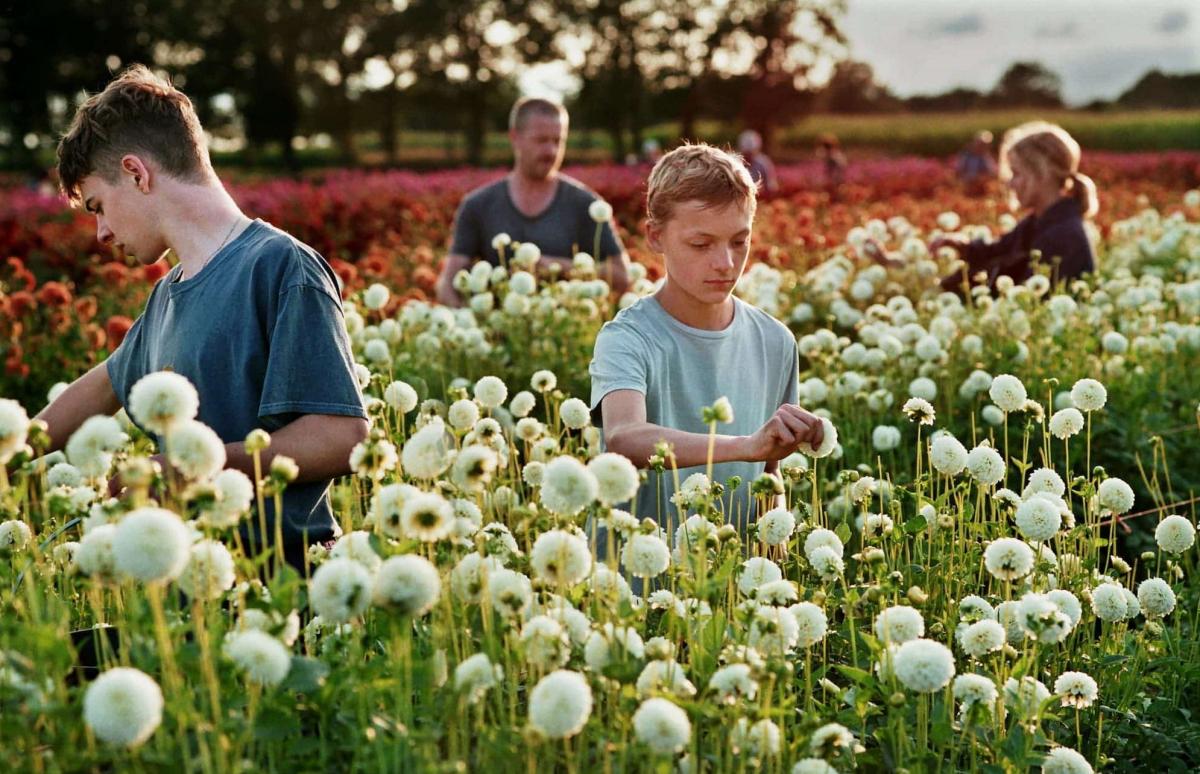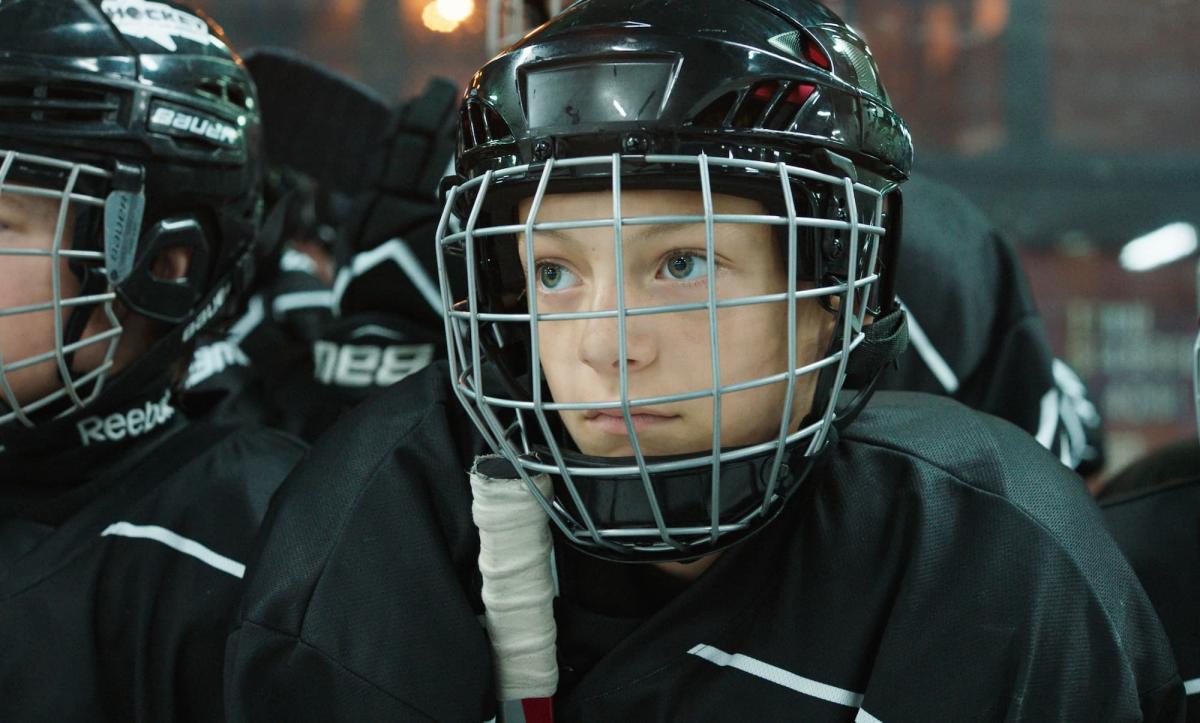A Belgian Miracle
Lukas Dhont’s Close

As they cross a vast flower meadow, Léo and Rémi playfully yell orders at each other in French. On the first day of school, a Dutch-speaking teacher welcomes them in neat standard language. During the hockey match, the coach gives orders in Flemish with an accent from the south-east part of Belgium, while the bench players shout encouragement in both national languages. A trip to the Belgian coast is accompanied by a Dutch-speaking and a French-speaking teacher, and during the class discussion afterwards, the pupils choose for themselves in which language to express their feelings about what they have just experienced. Rémi mumbles in Dutch that he has a stomach-ache when his Dutch-speaking father asks him why he didn’t finish his plate. Other characters also juggle both national languages deftly and switch effortlessly depending on the context. Brussels, the bilingual capital, which was the setting for Dhont’s first film, does not come into view, making it difficult to culturally and socially identify the space in which the story takes place. Are we in a village around the Belgian language border? A municipality with language facilities?1 There is, in the fictional world of Close, no sign of the tension between the two Belgian linguistic communities that usually prevails there. Bilingualism is taken for granted, which contrasts sharply with the current Belgian political climate of two communities growing ever further apart.
Close is a collaboration between Belgium, the Netherlands and France. The production requirements of such an international co-production possibly explain why the film was partly shot in Dutch flower fields and the dialogues are predominantly in French. In addition, the film is also an “intranational” co-production between Flanders and the French-speaking Belgian community, and it seems that this “Belgian” financing structure has had repercussions in the form of bilingualism.
Besides productional concerns, there are other issues at play. Since the turn of the century, quite a few Belgian – mainly Flemish – filmmakers have been explicitly focusing on Belgian identity. Whereas before films from the French-speaking and Dutch-speaking parts of Belgium almost exclusively grafted on the cultural identity of the respective linguistic community, recent films like Rundskop (2011), Image (2014), Wasteland (2014), Cleo (2019) and Dhont’s debut Girl (2018) employ an overtly Belgian framework. Bilingual Brussels natives featured in the films feel neither Flemish nor Walloon, but identify with a Belgian in-between identity. In Le fidèle (2017) – an anagram of “liefde”, the Dutch-language word “love” – Gigi, an inhabitant of Brussels played by Matthias Schoenaerts, navigates between French and Dutch with ease. The gangster even robs banks in both languages, with a Brussels accent peppered with “belgicisms” (“non peut-être!”). The fact that the boss of the bank is a racist Flemish-nationalist from Dilbeek – a municipality in the periphery of Brussels “where Flemings are at home”2 – is no coincidence. It’s not uncommon for these films to explicitly oppose Flemish-nationalist sentiment. Against a homogeneous Flemish (and, to a lesser extent, Walloon) culture, they set a “new belgitude” expressing openness, heterogeneity and cosmopolitanism.
Unlike in the rest of Europe, where the local and the global are diametrically opposed, the anti-national tendency in Belgium carries the national tricolour. Although national identity in a globalised world usually has to give way to what Stuart Hall calls “new forms of belonging”, Belgian identity can easily be reconciled with postmodern interpretations of identity grafted onto gender, sexuality or race. Within Belgian cinema, this paradox translates into films that express their tolerance and openness by waving a Belgian flag. For instance, the distinctly Belgian position between two language communities in which the main character from Girl finds herself seems a metaphor for her border position between genders, seamlessly blending national and gender identity. Similarly, Lola vers la mer (2019) juxtaposes the transgender identity of the open-minded, bilingual main character with the conservative attitude of her father, whose intolerance towards Flemings and his daughter’s transition seem to stem from the same narrow-minded worldview.
Close drives home the paradox of a postnational national identity. Whereas Belgian cosmopolitanism in films like Le fidèle and Girl is still somewhat anchored in a cultural reality, Close deliberately leaves existing Belgium behind. At the crossroads between the local and the global, the film oscillates between hyper-Belgian and hyper-universal. The result is an abstract, postnational Belgian identity, stripped of cultural specificity. The film merely expresses a make-believe image of Belgium and leaves out its concrete complexity. In the absence of a meaningful reference to the existing country, the representation of Belgium becomes a self-referential simulacrum whose meaning is limited to the diegetic space.
With the concept of “banal nationalism”, Michael Billig draws our attention to invisible forms of nationalism. Even established nations, Billig argues, need to be constantly reproduced through symbols, conventions, customs and rituals embedded in our daily lives. He expands the concept of nationalism to include not only fanatical flag wavers, but also the flag hanging inconspicuously on the façade of a public building. To clarify his argument, Billig refers to the Belgian situation: “Nationalism is not merely the ideology which is impelling Flemish speakers to resist the Belgian state. It is also the ideology which permits the states, including the Belgian state, to exist. In the absence of an overt political challenge, like that mounted by the Flemish speakers, this ideology might appear banal, routine, almost invisible.”
Likewise, films are steeped in banal nationalism. Unlike “hot” nationalism, it usually lurks in the background. It creeps into the film in the form of Belgian beer, a tone of voice, word choices or clothing style. The viewer does not register these invisible forms of what Billig calls “flagging” as explicit expressions of nationalism. They are subtly woven into the film, and their banality blends them into the wider meaning. In Close, Dhont seems to want to deploy bilingualism as a banal reference to Belgium, but the eagerness with which he tries to hide it in the folds of the narrative just renders it garish. After a traumatic event, the pupils are given the chance to share their thoughts and feelings with each other under the watchful eye of a bilingual teacher. After Rémi expresses his indifference in French, a classmate begins to express his experience in Dutch. The Dutch sentence is abruptly interrupted by the editing, indicating that what matters to the filmmaker is not the content of the sentence but the signalling of unproblematic bilingualism. However, the Belgian viewer notices the subliminal reference immediately, precisely because of its frenetic spontaneity.
The Belgian miracle unfolding in Close contrasts sharply with the political and cultural reality in which the country finds itself. The film wants to portray bilingualism as banal, but the Belgian flag Dhont discreetly raises in the background flies fiercely in the communitarian storm raging through the country. When Léo and Rémi enter the playground, the playing children around them speak mostly French. In the French-speaking noise, a word of Dutch can be discerned here and there, skilfully hidden in the relief of the soundtrack. The Dutch-language interruptions attract attention. What is meant to be neutral and meaningless background noise comes to the fore and takes on cultural overtones. The apparent nonchalance of the gesture betrays an underlying wilfulness. In an attempt not to politicise the linguistic conflict, Dhont made a decidedly political film.
Thomas Elsaesser describes how European filmmakers “serve two masters”: the home market and the international (festival) circuit. This “double consciousness” adapts local specificity to the expectations of a foreign gaze by reformulating it in an international register. The fictional Belgium Dhont sketches seems to serve a foreign master above all. As he himself points out, unproblematic bilingualism catches on beyond national borders: “The audience appreciates that we let the two languages coexist without attaching much meaning to them. Internationally, this allows the film to go wider.” Close was made to win awards, capture the biggest possible market and move an audience sentimentally. To achieve that goal, the film regularly turns its back on reality. With the purpose of going to Cannes, Belgium is hollowed out into an export product for a European market. After all, the artificial community symbiosis is easier to digest abroad than the reality of a bicultural country with a layered national identity. The result is a generic Belgium, in which languages and communities, as on paper, meet without difficulty, which is not coincidentally the federal wet dream of a Europe that promotes “unity in diversity”.
The discrepancy between the constructed image of Belgium and the realistic register in which Dhont paints that image is exemplary of the manipulative strategies employed by the filmmaker, which characterise the film as a whole. Behind the seemingly casual sketch of the reality in which the characters dwell lies a compulsive craving for control. The observational approach mostly masks a moralising attitude, in which cultural and social complexities are swept away by a deceptive marriage of aesthetics and morality.

- 1Some municipalities around the language border are exempt from the principle of unilingualism and have special language regulations. The linguistic conflict is generally more noticeable in these municipalities.
- 2The slogan “where Flemings are at home” can be read on several official signs around the municipality of Dilbeek.
Images from Close (Lukas Dhont, 2022)

